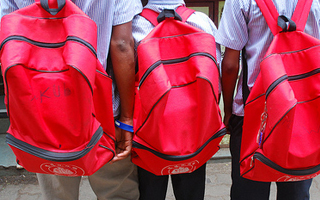According to an international study, daily backpack carrying has been shown to be the most frequent cause of discomfort for school children. School backpacks were felt to be heavy by 79.1% of children, caused them fatigue in 65.7% and caused back pain in 46.1%.
School can be a challenging time for children, so ensuing they are as comfortable as possible will help them develop physically and mentally to their full potential. Therefore special care should be taken when packing your child’s school bag to avoid any long-standing damage being done to their spine.
1. Buy the right size bag
In a recent study in Australian Spine, 80 percent of school children stated that their school bag feels too heavy. This means firstly buying a schoolbag that is appropriate to your child’s size and not over-sized so it will last longer and you save money.
A backpack is recommended, rather than a bag that is carried, or slung over one shoulder, as this will cause uneven weight distribution and torsion on the spine. The best backpacks have a molded frame, padded back, adjustable straps, a waist belt and should be relatively water resistant.
2. Pack a school bag correctly
When looking for a schoolbag, look for one that has a few separate compartments to help with packing. This way you will be able to position the heaviest items next to a child’s back, slotting books and lunch boxes firmly into place, so they don’t move around when in transit. A badly packed bag will shift your child’s center of gravity and potentially cause back strain and maybe even increase the lumbar lordosis (low back curve). A drink bottle holder outside the bag is a good idea to save spillage and damp school books.
3. Don’t overload the bag
A backpack should not weigh more than 10% of your child’s body weight. So for a 40kg child this would equate to 4kg. Unfortunately this only equals a few books and a large lunchbox; therefore a lot of children are carrying more weight than is healthy. Try to encourage your child to only carry the essentials in their bag and to leave as much as they can in their lockers or desk at school and make sure they pack their bags everyday.
4. Carrying and lifting strategies
When lifting the bag, try and make sure they lift with a straight back, bending at the knees, and the bottom of the bag sits above their waist rather than hanging too low. It should sit on their hips and high on their back, not slung low or over one shoulder. If the bag has a waist strap, it should be used to help distribute the weight from the shoulders onto the hips.
They should be aware that poor carrying techniques could affect their backs and cause permanent damage, which can last a lifetime. If your child has to lean forward whilst wearing the bag, it is most likely fitted incorrectly.
5. Get your Neurohealth practitioner to correctly assess
If you are still unsure, ask one of the practitioners at Neurohealth Chiropractic to correctly assess the bag your child is using and even to demonstrate exactly how it should be worn.
This article is written by Steven Cannon – Chiropractor @ Neurohealth




